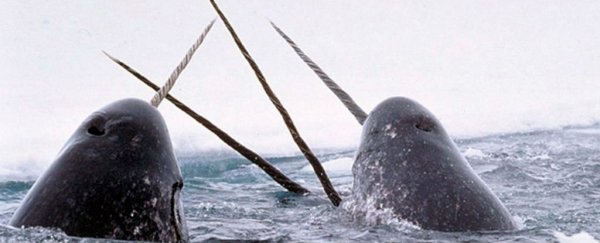Drone footage has captured something no one's ever seen before - wild narwhals using their bizarre tusks to hunt Arctic cod by hitting and stunning them, making them easier to consume.
The behaviour addresses a biological mystery that's spanned decades - why these rare and elusive whales have evolved an extra-long left canine tooth that bursts through the upper lip and protrudes from the head like the horn of a unicorn.
The footage was captured by two drones in Tremblay Sound, Nunavat, in northeastern Canada, which were operated by Adam Ravetch from the World Wildlife Fund (WWF) Canada and researchers from Fisheries and Oceans Canada.
"This is an entirely new observation of how the tusk is used," Brandon Laforest, a senior specialist of Arctic species and ecosystems with WWF-Canada, told National Geographic.
The mystery of these 'horns' - which can grow up to 2.7 metres (9 feet) long - has led scientists to pose a number of possible functions, including signals of testicle size, navigation, and territorial battles.
But there's been one obvious gap in the evidence - these things look a whole lot like weapons, so are they using them to hunt too?
Turns out, they are, as you can see in the footage below:
Now that we've witnessed this behaviour for the first time, it's become clear that the narwhal tusk is a multipurpose appendage that really was worth the cost of evolving the most unusual tooth in nature.
Late last year, researchers discovered that this tusk helps narwhals 'see' like no other species on Earth - when they measured the whales' echolocation skills, they found that they have the most directional sonar ever detected.
Like dolphins and other whales, they're able to navigate dark, murky waters by producing clicking sounds at a rate of up to 1,000 clicks per second, and using the echoes to reconstruct their surroundings based on how the sound waves bounce off nearby prey or rock formations.
Previous research had found that the narwhal tooth had foregone the protection of hard, external enamel to make it sensitive to even the tiniest of stimuli - and this appears to have given them the edge over all other echolocating species.
Scientists suspect that the tooth plays a role in echolocation by allowing seawater to enter it through pores in its tip. Bubbles then travel through the shaft and excite nerve endings at the base of the tooth near the head, sending signals to the brain about the narwhal's surroundings.
This sensitivity suggests that the narwhal tusk isn't something to be used haphazardly - you'll notice in the footage above that those hunting taps are extremely gentle.
It also reveals the cost of narwhal territorial battles (as seen in the image at the top of the page), which involve bashing their most sensitive appendages against each other.
We should note that the behaviour in the drone footage has not been published in a peer-reviewed journal at this stage, so any interpretations of what we're seeing will have to be independently verified.
But this is the first time we've ever seen the mysterious narwhal tusk being used for hunting, which could be the final piece of the puzzle for this bizarre oddity of evolution.
